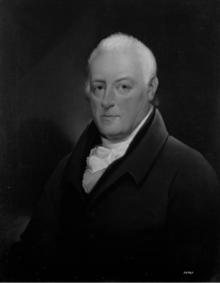
Back جون لانسينج ARZ جان لانزینق جر. AZB John Lansing German جان لنسینگ جونیور Persian ジョン・ランシング・ジュニア Japanese Ioannes Lansing Latin Джон Ленсинг Ukrainian 约翰·兰辛 Chinese
John Lansing Jr. | |
|---|---|
 | |
| Chancellor of New York | |
| In office 1801–1814 | |
| Preceded by | Robert R. Livingston |
| Succeeded by | James Kent |
| Mayor of Albany, New York | |
| In office 1786–1790 | |
| Preceded by | Johannes Jacobse Beekman |
| Succeeded by | Abraham Yates Jr. |
| Personal details | |
| Born | John Ten Eyck Lansing Jr. January 30, 1754 Albany, New York, U.S. |
| Died | December 12, 1829 (disappeared) (aged 75) New York City, New York, U.S. |
| Spouse |
Cornelia Ray
(m. 1781; his disappearance 1829) |
| Parent(s) | Gerrit Jacob Lansing Jannetje Waters |
| Relatives | Abraham Lansing (brother) Gerrit Lansing (nephew) Robert Lansing (nephew) |
John Ten Eyck Lansing Jr. (January 30, 1754 – vanished December 12, 1829), a Founding Father of the United States, was an attorney, jurist, and politician.[1][2]
Born and raised in Albany, New York, Lansing was trained as a lawyer, and was long involved in politics and government. During the American Revolution he was military secretary to General Philip Schuyler. Lansing served in the New York State Assembly from 1781 to 1784, in 1786, and in 1789; served as Speaker of the Assembly in 1786 and 1789; served as a member of the Congress of the Confederation in 1785; and served as mayor of Albany from 1786 to 1790. He was a delegate to the federal Constitutional Convention in 1787, but withdrew from the body in July because he opposed the proposed United States Constitution as infringing on state and individual rights. He was a delegate to the New York ratification convention in June 1788, but was unable to prevent the Constitution from being approved.
In 1790, Lansing was a member of the commission that settled the New York-Vermont boundary as part of Vermont's admission to the Union as the fourteenth state in 1791. He was a justice of the New York Supreme Court from 1790 to 1798, and chief justice from 1798 to 1801. He was also Chancellor of New York from 1801 to 1814, and in 1817 was a special commissioner to resolve New York City and New York County claims to land in Vermont. From 1817 until his death, he was regent of the University of the State of New York. Lansing disappeared in December 1829, after leaving his New York City hotel room to mail a letter. No trace was ever found, and what happened to Lansing remains unknown.
- ^ "John Lansing, Jr. Associate Justice of the Supreme Court, 1790-1798 Chief Justice, 1798-1801". nycourts.gov. Retrieved August 28, 2017.
- ^ "LANSING, John Jr. – Biographical Information". bioguide.congress.gov. Biographical Directory of the United States Congress. Retrieved August 28, 2017.